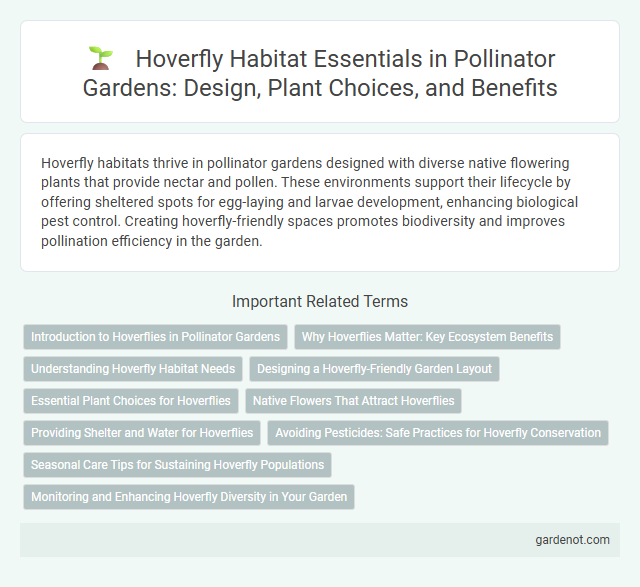Hoverfly habitats thrive in pollinator gardens designed with diverse native flowering plants that provide nectar and pollen. These environments support their lifecycle by offering sheltered spots for egg-laying and larvae development, enhancing biological pest control. Creating hoverfly-friendly spaces promotes biodiversity and improves pollination efficiency in the garden.
Introduction to Hoverflies in Pollinator Gardens
Hoverflies play a vital role in pollinator gardens by providing essential pollination services and natural pest control. These beneficial insects thrive in habitats rich in flowering plants, especially those with abundant nectar and pollen sources. Establishing diverse, pesticide-free environments attracts hoverflies, enhancing garden biodiversity and supporting healthy ecosystems.
Why Hoverflies Matter: Key Ecosystem Benefits
Hoverflies contribute significantly to pollination, supporting the reproduction of numerous flowering plants and enhancing biodiversity in pollinator gardens. Their larvae play a crucial role in controlling aphid populations, providing natural pest management and reducing the need for chemical pesticides. By sustaining plant health and boosting crop yields, hoverflies are vital for maintaining balanced ecosystems and promoting sustainable garden practices.
Understanding Hoverfly Habitat Needs
Hoverfly habitat needs include abundant flowering plants that provide nectar and pollen as primary food sources, alongside nearby water sources for hydration and breeding. Larval habitats require decaying organic matter, such as compost heaps or moist soil rich in algae, which supports the development of larvae by supplying essential nutrients. Preserving diverse vegetation and minimizing pesticide use are crucial for maintaining hoverfly populations and ensuring effective pollination in garden ecosystems.
Designing a Hoverfly-Friendly Garden Layout
Designing a hoverfly-friendly garden layout requires incorporating diverse native flowering plants that provide nectar and pollen throughout the growing season, supporting adult hoverflies. Including undisturbed areas with decaying organic matter or mulch creates ideal breeding and larval habitats, as hoverfly larvae feed on aphids and other pests. Strategic placement of water sources and sheltered spots enhances habitat suitability, promoting hoverfly population growth and effective pollination.
Essential Plant Choices for Hoverflies
Essential plant choices for hoverflies in a pollinator garden include nectar-rich flowers like dill, fennel, and coriander, which support their adult feeding needs. Incorporating native flowering plants such as yarrow, marigolds, and wild carrot creates optimal breeding and hunting habitats for hoverfly larvae. Selecting plants with diverse bloom periods ensures continuous nourishment, promoting hoverfly populations that enhance pollination and natural pest control.
Native Flowers That Attract Hoverflies
Native flowers such as yarrow, wild carrot, and dill create ideal habitats that attract hoverflies by providing abundant nectar and pollen. Hoverflies are vital pollinators that improve garden biodiversity while controlling aphid populations. Incorporating these native plants enhances hoverfly activity and supports ecological balance in pollinator gardens.
Providing Shelter and Water for Hoverflies
Hoverfly habitats thrive when shelter is provided through dense vegetation, leaf litter, and hollow stems, creating safe spaces for resting and breeding. Incorporating shallow water sources with stones or floating plants ensures hoverflies have accessible hydration without risk of drowning. Providing these essential elements in a pollinator garden supports hoverfly populations, enhancing pollination and natural pest control.
Avoiding Pesticides: Safe Practices for Hoverfly Conservation
Hoverflies thrive in pesticide-free environments where diverse flowering plants provide essential nectar and pollen. Avoiding chemical insecticides and herbicides protects hoverfly larvae, which consume aphids and contribute to natural pest control. Establishing organic gardening practices enhances hoverfly habitat quality and supports their crucial role in pollination and ecosystem balance.
Seasonal Care Tips for Sustaining Hoverfly Populations
Hoverfly populations thrive in gardens that provide diverse flowering plants and consistent moisture throughout the growing season. Maintaining a habitat with early spring blooms, mid-summer nectar sources, and late-season pollen ensures continuous food supply for hoverflies. Regular removal of invasive weeds and minimal pesticide use promote a safe environment for hoverfly larvae and adults, supporting sustainable pollination.
Monitoring and Enhancing Hoverfly Diversity in Your Garden
Regular monitoring of hoverfly populations in your pollinator garden helps track species diversity and abundance, ensuring a healthy ecosystem. Enhancing hoverfly habitat can be achieved by planting a variety of native flowering plants that bloom sequentially from spring to fall, providing continuous nectar and pollen sources. Incorporating sheltered areas such as hedgerows and leaving patches of bare soil supports hoverfly larvae development and promotes population growth.
Hoverfly habitat Infographic

 gardenot.com
gardenot.com